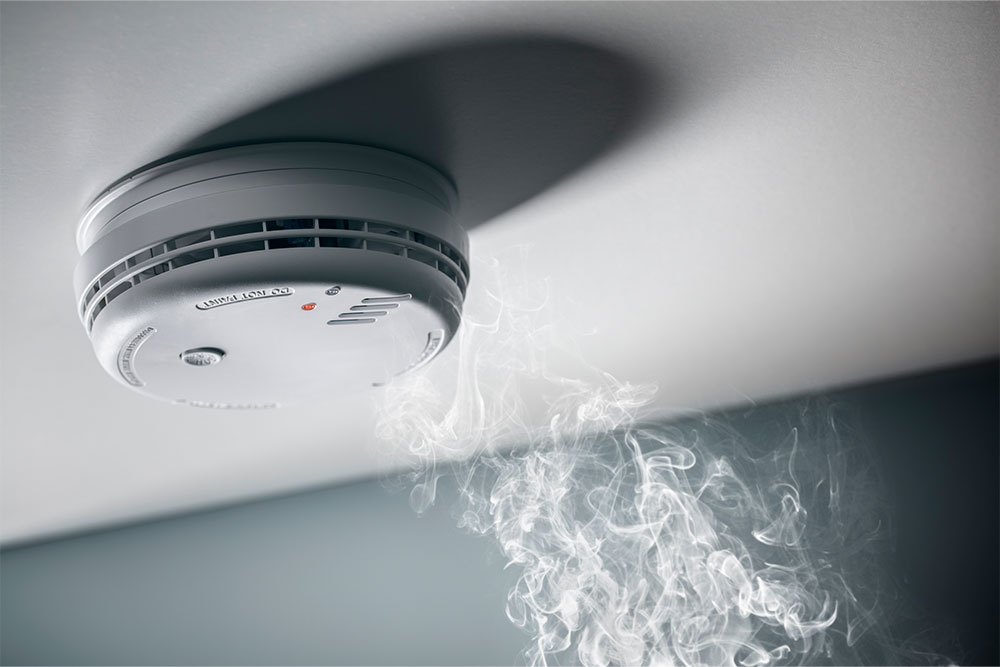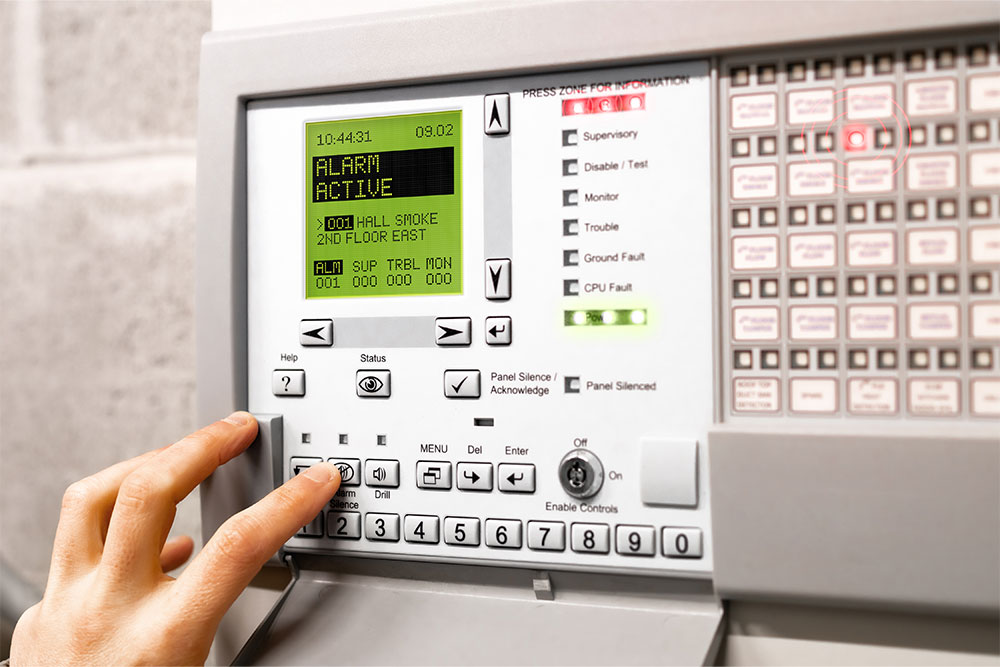
Knowing how to turn off a fire alarm is important, especially in a commercial building. Fire alarms are essential for safety, but false alarms can cause confusion, panic and frustration. Learning the right way to silence and reset alarms helps keep everyone calm and ensures the building remains protected.
In this blog, we’ll explain how to turn off fire alarms in commercial and residential settings. Whether you’re managing an office or dealing with a noisy smoke detector at home, this guide will help you handle the situation safely.
Types of Fire Alarm
Fire alarm systems detect smoke, heat or flames in a building. Upon detection, they alert occupants, giving them time to evacuate the premises safely.
While fire alarms are commonly found in both commercial and domestic settings, there are key differences in their design and functionality.
Commercial fire alarm systems are more complex because they monitor larger properties. They are usually connected to a central control panel that monitors multiple zones within a building.
Domestic fire alarms are simpler, standalone units. These alarms are often battery-operated or connected to the household’s electrical system.
Fire Alarm vs Smoke Alarm
Fire Alarms
Fire alarms are multi-component systems used in commercial, industrial and large residential buildings. These systems are built to detect fire, smoke and heat across multiple areas and alert people to evacuate.
Here’s what a fire alarm typically includes:
- Smoke and heat detectors to identify different fire types.
- Manual call points (those break-glass units you see on walls).
- Loud alarms and flashing lights to alert everyone.
- A central control panel that monitors and manages the entire system
Fire alarms are usually hardwired into a building’s electrical system with a backup battery so they can continue working during power cuts.
Some systems also connect to sprinklers, emergency lighting and fire and rescue services. If this type of fire alarm activates, it will also trigger the connected devices and alert the emergency services.
Fire alarms are essential in larger buildings that need a coordinated fire response. But they typically come with higher costs for installation, maintenance and professional servicing.
Fire Safety Training
Our Fire Safety Training course gives a basic understanding of fire prevention principles, the sources of ignition and fuel and safe systems of work to prevent fire hazards and accidents within the work environment.
Smoke Alarms
A smoke alarm is a standalone device designed for homes and small buildings. Unlike fire alarms, a smoke alarm doesn’t connect to a control panel or external monitoring system. Instead, it’s a compact unit with:
- A built-in smoke sensor (ionisation for fast-burning fires, photoelectric for slow-burning fires).
- A loud siren that activates when smoke is detected.
- A power source (battery or mains-powered with backup).
Smoke alarms only detect smoke – they don’t monitor heat or flames. They also don’t alert emergency services automatically. If a smoke alarm goes off, it’s up to you to act.
Despite their limits, smoke alarms have a couple of clear advantages: affordability and easy installation. Smoke alarms are cheap, require little maintenance and work well for small spaces where a simple warning siren is enough to alert everyone in the building.
All you need to do is test the alarm each month and replace the batteries at least once a year.

Which One Do You Need?
- Fire alarms are for large buildings that need multi-zone detection and automatic emergency response. They require professional installation and regular servicing.
- Smoke alarms are for smaller buildings where a single siren can alert every occupant of a potential fire. They’re simple to install and maintain.
If you’re protecting a house or small workplace, a smoke alarm is probably enough. (Check this against your workplace’s fire risk assessment, though.)
Larger, more complex premises will need a suitable fire alarm system.
How to Turn Off a Fire Alarm in a Commercial Building
Turning off a fire alarm in a commercial building needs careful attention. Commercial fire alarms are more complex than those in ho,mes and mishandling them can lead to problems. Here’s how to manage these alarms safely.
Identify the Type of Fire Alarm System
First, you need to know what type of fire alarm system you have. Here are the main types found in commercial buildings:
Conventional Fire Alarm Systems
Conventional systems are often used in smaller buildings. They divide the building into zones. When an alarm goes off, the control panel shows which zone has the issue but not the exact location of the possible fire.
Addressable Fire Alarm Systems
Addressable systems are more advanced and standard in large buildings like offices and hospitals. They’re made up of multiple devices, such as heat or smoke detectors and manual call points.
Each device in the system has a unique address. When it triggers, the control panel shows the exact location, allowing for a quicker response. Addressable fire alarms are easier to manage but cost more than conventional systems.
Wireless Fire Alarm Systems
Wireless systems work like addressable systems but use wireless communication. They’re flexible and useful in buildings where installing wires is difficult but rely on batteries that need regular checks.
Hybrid Fire Alarm Systems
Hybrid systems combine features of both conventional and addressable systems. They offer a balanced approach, providing the right solution based on the specific needs of different areas within the building.
Accessing the Control Panel
After identifying the system, find the control panel. It’s usually in a central spot, like near the main entrance or in the security office. The control panel is where you can monitor, silence and reset the alarms.
Only trained people should use the control panel, so access is typically restricted. You’ll likely need a key or code to reach it.

Disabling the Alarm
Here’s how to turn off the alarm:
- Check the Control Panel: Look at the control panel to see where the alarm was triggered. This will help you determine whether it’s a false alarm or a real emergency.
- Enter the Code or Use a Key: Most control panels need a code or a key to operate. This is to make sure only authorised people can silence the alarm.
- Press the Silence Button: After you’re authorised, press the ‘Silence’ button on the panel. This will stop the alarm sound, but it doesn’t reset the system. Always make sure there’s no actual fire before silencing the alarm.
Resetting the System
Once the alarm is silenced, you need to reset the system:
- Investigate the Cause: Before resetting, check why the alarm went off to make sure it was a false alarm.
- Press the Reset Button: On the control panel, press the ‘Reset’ button to clear the alarm and return the system to normal.
- Monitor the System: After resetting, keep an eye on the system to ensure it’s working correctly. If the alarm goes off again, there might be an issue that needs more attention.
When to Call a Professional
If you have trouble silencing or resetting the alarm, or if it keeps going off without a reason, it’s best to call a professional. They can check the system and fix any issues to make sure the building remains safe. Never ignore an alarm that can’t be reset, as it could put everyone at risk.
How to Turn Off a Domestic Fire Alarm
Domestic fire alarms are essential for protecting homes, but they can sometimes be triggered accidentally or start beeping for no clear reason. If your home fire alarm is acting up, follow these steps to turn off and reset it.
Locating the Alarm and Power Source
It’s safest to have multiple smoke detectors or fire alarms in your home. Locate the alarm that’s been triggered. Once you find the alarm, check its power source. Domestic fire alarms are typically powered in one of three ways:
- Battery-Operated Alarms: These are the most common type found in homes. They rely entirely on batteries, which need to be replaced periodically.
- Mains-Power Alarms: These alarms are connected to the home’s electrical system and may have a backup battery. They won’t fail during a power cut, but the backup battery must be checked regularly.
- Interconnected Systems: In some homes, multiple alarms are interconnected, meaning if one alarm is triggered, all alarms will sound. These systems can be either battery-operated, mains-powered or a combination of both.
Handling Beeping Fire Alarms
A common issue with domestic fire alarms is persistent beeping, which usually indicates a problem that needs to be addressed. Here are some possible causes and solutions:
- Low Battery: If your alarm is battery-operated, the most common reason for beeping is a low battery. Replacing the battery should stop the noise.
- Dust or Debris: Dust inside the alarm can cause it to beep. You can clean the alarm by removing it from its mounting and gently vacuuming the inside.
- End of Life: Most smoke alarms last around ten years. If your alarm is beeping and is near or past this age, it may be time to replace the unit entirely.
- Power Issues: For mains-powered alarms, a beeping sound might indicate a problem with the power supply. A professional electrician should check if the alarm is correctly connected to the electrical system and that the backup battery is functioning.
Resetting the Alarm
After addressing the cause of the beeping, you’ll need to reset the alarm. Here’s how:
- Press the Silence or Reset Button: Most domestic fire alarms have a button to temporarily silence the alarm. If the underlying issue has been resolved, pressing this button should stop the alarm.
- Turn Off the Power (if necessary): If the alarm doesn’t have a reset button, or if the alarm continues to sound after pressing it, you may need to temporarily turn off the power. For battery-operated alarms, remove the battery, wait a few seconds and then reinsert it. For mains-powered alarms, you may need to turn off the power at the circuit breaker.
- Reinstall or Reconnect the Alarm: Once the alarm has been reset, ensure it’s properly reinstalled and connected to its power source. Test the alarm to make sure it’s working correctly.
When to Replace the Alarm
If your alarm continues to malfunction after resetting, it might be time to replace it. Always follow the manufacturer’s guidelines for maintenance and replacement to ensure your home remains protected.
General Fire Safety Precautions
If you’re responsible for fire safety, you need to know more than just how to turn off alarms. Here are some essential precautions:
Ensuring Appropriate Fire Safety Levels
- Conduct a Fire Risk Assessment: Workplace fire risk assessments are a legal requirement and a crucial first step in identifying fire hazards and determining the necessary precautions. Your assessment helps you understand the specific risks within your building and ensures that appropriate fire safety measures, including alarms and extinguishers, are in place.
- Regular Testing and Maintenance of Alarms: Both commercial and domestic fire alarms should be tested regularly. Replace batteries as needed and address any issues immediately to ensure they function correctly in an emergency.
- Fire Extinguishers: Make sure that fire extinguishers are available in key areas of your building. Regularly inspect them to ensure they are ready for use. Understanding how to inspect and maintain these extinguishers is crucial, which is where targeted training comes into play.
Conducting Regular Fire Safety Checks
- Fire Alarm Systems: Regular inspections of fire alarm systems are essential, especially in commercial settings where more complex systems may require professional maintenance.
- Fire Extinguishers: Regular checks ensure that extinguishers are in good condition and accessible when needed.
How to Turn Off a Fire Alarm – Key Takeaways
- Identify your fire alarm system (conventional, addressable, wireless or hybrid) before attempting to turn off and reset it.
- Follow proper procedures. Only access the fire control panel to turn off the alarm if you’re trained and authorised to do so.
- Conduct regular testing and maintenance of fire alarms and extinguishers to ensure they’re in safe working order.
- Refer to your fire risk assessment to ensure your workplace has an appropriate fire alarm system and firefighting equipment.
Fire Extinguisher Training
If you’re responsible for workplace fire safety, understanding how to turn off a fire alarm is critical for maintaining safety and avoiding unnecessary panic. You must also know how to check firefighting equipment is kept in safe working order.
Our online Fire Extinguisher Training will equip you with the skills needed to inspect fire extinguishers and ensure they’re ready to use in an emergency. The course provides comprehensive guidance on inspecting and maintaining fire extinguishers, helping you comply with regulations and uphold fire safety standards in your workplace.





















